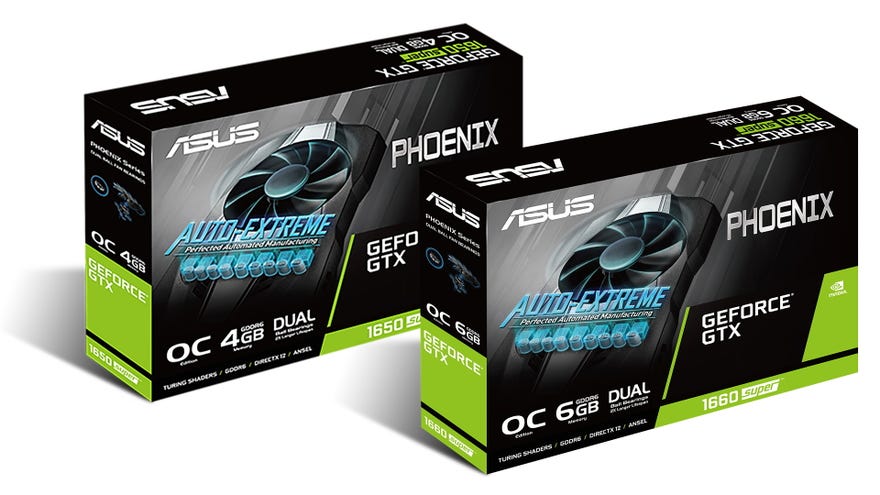Surprise! Nvidia's GTX 1660 Super and 1650 Super are real and I still don't know why they exist
Super duper?
In March and April of this year, Nvidia released their excellent GTX 1660 graphics card and their slightly less impressive GTX 1650. While the latter wasn't much cop compared to AMD's existing RX 570 GPU, the former went straight in as our best graphics card choice for 1080p gaming. Now, for some reason, Nvidia have decided to replace those cards with even shinier Super editions, just six months after they first came out.
You may remember I was slightly baffled by the potential existence of these cards when they first appeared on the graphics card rumour circuit back in September. From a performance perspective, I just couldn't see where another 1660 card could possibly fit between the current GTX 1660 and the GTX 1660 Ti, and to be honest, I'm still not sure why Nvidia have felt the need to introduce yet another set of cards so soon after their initial release.
Perhaps it's so they've got something to shout about while AMD get their act together on their upcoming RX 5500 graphics card, which is also meant to be on the budget-side of the 1080p spectrum, or maybe those mad graphics wizards just can't stop making the damn things. Whatever the reason, it shall remain an eternal mystery.
I'll be testing both cards in due course with full reviews and comparison pieces to show exactly how they compare to their non-Super siblings, but right now, here's everything we know about them so far.
GTX 1660 Super release date
Let's get the important stuff out of the way first. The GTX 1660 Super is out today, October 29th, while the GTX 1650 Super's release date is currently set for November 22nd.
We still have no idea when AMD will be releasing their RX 5500 card (so far all they've said is before the end of the year), but if they're not careful they could suffer another case of the gazumps, just like they did when Nvidia released their first batch of RTX Super cards a week before their RX 5700 family.
GTX 1660 Super price
Right now, I've only been given the US pricing for the GTX 1660 Super, but you should start seeing third party models start at $229. That's the same price as existing GTX 1660 cards, although Nvidia have told me that current GTX 1660 cards will be getting some sort of price cut to make them a more obvious entry-point to the 1660 family. What that price cut will actually entail, I don't yet know.
The GTX 1650 Super, meanwhile, doesn't have any official pricing just yet. That will likely come next week when it launches properly.
GTX 1660 Super specs
The GTX 1660 Super is based on the 12th generation of Nvidia's Turing GPU, and you can see the full specs table below. The main difference between the GTX 1660 and the GTX 1660 Super is that the Super card now has GDDR6 memory clocked at 14 Gbps instead of GDDR5 memory clocked at 8 Gbps. This gives the Super card a peak memory bandwidth of 336GB/s, compared to the regular GTX 1660's 192GB/s bandwidth, which, according to Nvidia, makes it up to 20% faster than the GTX 1660 and 1.5x faster than the 6GB GTX 1060.
| GTX 1650 | GTX 1650 Super | GTX 1660 | GTX 1660 Super | GTX 1660 Ti | |
|---|---|---|---|---|---|
| CUDA Cores | 896 | 1280 | 1408 | 1408 | 1536 |
| Base Clock | 1485MHz | 1530MHz | 1530MHz | 1530MHz | 1500MHz |
| Boost Clock | 1665MHz | 1725MHz | 1785MHz | 1785MHz | 1770MHz |
| Memory | 4GB GDDR5 | 4GB GDDR6 | 6GB GDDR5 | 6GB GDDR6 | 6GB GDDR6 |
| Memory Clock | 8 Gbps | 12 Gbps | 8 Gbps | 14 Gbps | 12 Gbps |
| Memory Bandwidth | 128GB/s | 192GB/s | 192GB/s | 336GB/s | 288GB/s |
| TDP | 75W | 100W | 120W | 125W | 120W |
The GTX 1650 Super, on the other hand, looks as though it's had a more substantial tune-up. It still has 4GB of memory, but this too has now been upgraded to the faster GDDR6 type and is now clocked at 12 Gbps, putting its memory bandwidth on the same playing field as the regular GTX 1660. Its base and boost clock speeds are also a lot higher, and it has a lot more CUDA cores to play with as well. Sadly, this means its TDP has now risen to 100W instead of 75W, so you'll likely have to use a power connector with it instead of just drawing all your necessary power straight from the motherboard.
The big question, of course, is whether all that will be enough to compete with AMD's Radeon RX 5500, which is set to come in 4GB and 8GB GDDR6 memory types, with respective base and boost clock speeds of 1717MHz and 1845MHz. We'll just have to wait and see.









